


xxxxxAs we have seen, the Pre-Raphaelite Brotherhood, formed in 1848 (Va) with the aim of returning to the artistic values of the Middle Ages and the serious subjects then portrayed, had virtually come to an end in 1854. By that year the founders, Dante Gabriel Rossetti, John Everett Millais, and Holman Hunt had gone their separate ways.Three years later, however, Rossetti met William Morris and Edward Burne-Jones, two young men who also admired the work of medieval artists and delighted in the romance of Arthurian legend. Their friendship resulted in the revival of the Pre-Raphaelite Brotherhood, a second generation of artists who were seriously alarmed at the deficiency in British industrial design, made only too evident by the machine produced items on display at the Great Exhibition in 1851. In 1861 William Morris founded a company which aimed not only to return to the purity of Medieval art, but also to revive the originality and quality once achieved in both handicraft and artistic design. By 1870 this company was meeting with considerable success both at home and on the continent.
THE PRE-RAPHAELITE BROTHERHOOD -
THE SECOND GENERATION 1870 (Vb)
Acknowledgements
Morris: portrait by the English painter George Frederick Watts (1817-1904), 1870 – National Portrait Gallery, London. Morris Artwork: Adoration of the Magi (tapestry) – Musee d’Orsay, Paris. Burne-Jones: portrait by the English painter George Frederick Watts (1817-1904), 1870 – City Museum, Birmingham, England; Burne-Jones Artwork: Baptism of Christ – Jesus Church, Troutbeck, Cumbria, England; The Beguiling of Merlin – Lady Lever Art Gallery, Liverpool, England; The Mirror of Venus – The Gulbenkian Foundation, Lisbon, Portugal; King Cophetua and the Beggar Maid – Tate Gallery, London; The Golden Stairway – Tate Gallery, London. Brown: Self-Portrait – City Gallery, Manchester, England; Christ washing St. Peter’s feet – Tate Gallery, London; Moses (stained glass) – St. Mary and St. Peter, Kelsale, Suffolk, England; Work – City Art Gallery, Manchester, England; Christ healing a woman (stained glass) – Chapel, Royal National Hospital, Ventnor, England. Webb: portrait by the English artist Charles Fairfax Murray (1849-1919), 1873 – National Portrait Gallery, London. Red House: date and artist unknown. De Morgan: portrait by his wife, the Pre-Raphaelite artist Evelyn De Morgan (1855-1919), 1893 – The De Morgan Centre, London.
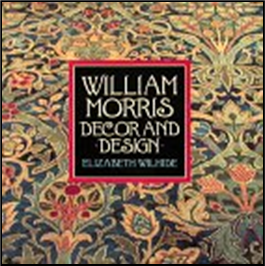 xxxxxAs we have seen, the Pre-Raphaelite Brotherhood which began in 1848 (Va), though initially successful, had virtually broken up by 1854, with the three founder members going their separate ways. Holman Hunt remained true to the spirit of the movement - namely a return to the pure artistic values of the Middle Ages - , but by then John Everett Millais was making a fortune pandering to public taste, and Dante Gabriel Rossetti, offended by the criticism levelled at his early paintings, had refused to exhibit his work in public. In the early 1860s, however, the movement gained a new lease of life and one which was to give it an enduring influence in the wider, practical world of handicraft and industrial design.
xxxxxAs we have seen, the Pre-Raphaelite Brotherhood which began in 1848 (Va), though initially successful, had virtually broken up by 1854, with the three founder members going their separate ways. Holman Hunt remained true to the spirit of the movement - namely a return to the pure artistic values of the Middle Ages - , but by then John Everett Millais was making a fortune pandering to public taste, and Dante Gabriel Rossetti, offended by the criticism levelled at his early paintings, had refused to exhibit his work in public. In the early 1860s, however, the movement gained a new lease of life and one which was to give it an enduring influence in the wider, practical world of handicraft and industrial design.
xxxxxIt was in 1857 that Rossetti took on the task of decorating the debating chamber of the Oxford Union with Arthurian frescoes, assisted by two undergraduates, William Morris and Edward Burne-Jones. Both these young men shared his love of all things medieval, and, with his encouragement, both took up artistic careers. Burne-Jones became a painter, whilst Morris embarked upon a career in the fine and applied arts. By 1870, a company Morris had formed in 1861 was having a significant impact on the revival of handicraft and artistic design, both at home and on the European continent. Under Morris’ energetic guidance the firm expanded rapidly over the next decade, recreating wide interest in the artistic achievements of the medieval period, and spawning the Arts and Crafts Movement in both Europe and North America.
xxxxxThis new circle of devotees to the Pre-Raphaelite cause - initially centred around Rossetti - and the second phase of activity it created, was not only based on a mutual admiration for the colour and purity of medieval designs and the romance of Arthurian legend. There was, too, a genuine concern - eloquently voiced at this time by the art critic John Ruskin and bluntly voiced by the historian Thomas Carlyle - about the dearth (if not death) of individual craftsmanship. The Great Exhibition of 1851, despite its public success, had revealed a serious deficiency in British industrial design. The age of machine production was providing a vast range of cheaply ornamented, identical products which were totally devoid of the individual style and quality of handmade goods, degrading, in the process, both the skill of the workman and the taste of the consumer.
Including:
William Morris,
Edward Burne-Jones,
Ford Madox Brown,
Philip Speakman Webb,
and William De Morgan.

Vb-1862-1880-Vb-1862-1880-Vb-1862-1880-Vb-1862-1880-Vb-1862-1880-Vb-1862-1880-Vb
xxxxxIt was with the aim of restoring the quality and originality of individual craftsmanship that the Englishman William Morris (1834-96) founded his design company in 1861. Assisted by the likes of Rossetti, Burne-Jones, Ford Maddox Brown and Philip Webb, he produced a large variety of decorative goods, specialising at first in the making of stained glass windows, and then going on to design and produce household items such as furniture, textiles, wallpaper, tapestries, tiles and jewellery. To accomplish this, Morris himself learnt a variety of skills, such as dying, weaving and printing. Notably successful were his intricate, stylised patterns for wallpapers and fabrics, influenced by the design of medieval illuminated manuscripts. And later in his career he turned to book production. In the 1890s he established the Kelmscott Press, and this produced 69 exquisite handmade volumes, including the famous The Works of Geoffrey Chaucer. But Morris, a man of extraordinary energy and drive, did not confine his talents to the visual arts. He was also a poet of distinction, with such poems as The Life and Death of Jason and The Earthly Paradise, wrote two successful fantasy novels, and, following visits to Iceland, he retold the heroic tales of the legendary hero Sigurd the Volsung. Then in 1876 he plunged into politics as a revolutionary socialist, goaded into action by the dreadful conditions endured by the miner and factory worker. Influenced by the writings of Marx and Engels, he established his own Socialist League in 1884 and spent many years involved in protest marches and public speaking throughout the country. Today, however, he is remembered above all as an outstanding art designer who revitalised interest in the beauty of medieval art and, by his regard for individual excellence, gave birth to the Arts and Craft Movement in Europe and North America.
xxxxxMorris had acquired a love of medieval times as a child. He was born at Walthamstow, Essex, and as a small boy, so we are told, used to ride his pony through the nearby woodland, dressed in a toy suit of armour like a knight of old. By the age of seven he had filled his young head with all the romantic, medieval tales of Walter Scott’s Waverly Novels. And it was as a self-styled “dreamer of dreams” that he attended Marlborough College and then went up to Exeter College, Oxford, bent at that time on entering the Church. It was here, however, that he became familiar with the writings of John Ruskin and Thomas Carlyle, and met the charismatic Gabriel Rossetti, a man with an abiding love of medieval art. This set him upon an artistic career. He spent close on a year studying architecture, but then in 1857 joined his close friend Burne-Jones in London to paint under Rossetti’s guidance. He made his intention clear: “I want to imitate Gabriel as much as I can”.
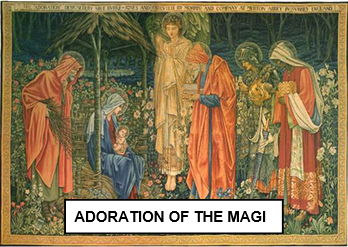
xxxxxBut Morris was too big a character and too talented a man to be so confined. In 1860, having married Jane Burden the previous year - the exotic model for his portrait La Belle Iseult - he found immense difficulty in furnishing and decorating their first home Red House, built in 14th century style at Bexleyheath in Kent by his architect friend Philip Webb. Appalled by the cheap and nasty machine-produced goods that were then flooding the market, he decided to use his ample wealth to establish a company specialising in the design and manufacture of decorative and useful goods, - a joyous return to the dedicated craftsmanship of the Middle Ages. In his hands, and those of his gifted colleagues, the Pre-Raphaelite movement had found a new, practical dimension, one which was to perpetuate, indeed, the beauty and the quality which had inspired its very beginning. Notable among many fine works were the two tapestries, Nativity and the Adoration of the Magi (illustrated above), and the redecoration of the armoury and tapestry rooms at St. James’ Palace, London.
xxxxxMorris’ energy and drive were not confined, however, to the visual arts. Ever restless, he was also a poet and writer of distinction. His early collection of poems, The Defence of Guenevere of 1858, a work full of medieval settings, was not well received by the critics, but his short narrative poem The Haystack in the Floods, a grim piece set in the Hundred Years’ War, showed promise by its easy style and steady pace. Fame and popularity came in the late 1860s with his The Life and Death of Jason (where he turned to Greek mythology) and The Earthly Paradise, a collection of 24 tales centred around a group of travellers of the 14th century who wander in search of an island free from old age and death. And, following two visits to Iceland in the early 1870s, he retold in English the heroic tales of the legendary hero Sigurd the Volsung, and went on to translate a number of Icelandic sagas, such as The Three Northern Love Stories. To the last three years of his life belong two fantasy novels, The Wood Beyond the World, and The Well at the World’s End, imaginative creations of his own weird and wonderful lands of make-believe.
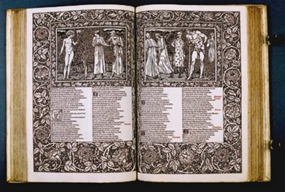 xxxxxAnd it was also in the 1890s that Morris established his Kelmscott Press in Hammersmith, London, to fulfil his love of medieval books and illustrated manuscripts. This press produced 69 exquisite handmade volumes, distinctively embellished by three new Gothic typefaces, woodcut illustrations by Burne-Jones, and decorative borders by Morris himself. These magnificently bound and printed editions included the master folio The Works of Geoffrey Chaucer (illustrated), published in 1896, the year of his death.
xxxxxAnd it was also in the 1890s that Morris established his Kelmscott Press in Hammersmith, London, to fulfil his love of medieval books and illustrated manuscripts. This press produced 69 exquisite handmade volumes, distinctively embellished by three new Gothic typefaces, woodcut illustrations by Burne-Jones, and decorative borders by Morris himself. These magnificently bound and printed editions included the master folio The Works of Geoffrey Chaucer (illustrated), published in 1896, the year of his death.
xxxxxAnd despite such demands on his time and energy, Morris also found a space in his life for active politics. He entered the field as a revolutionary socialist in 1876, goaded into action by the dreadful conditions endured by the factory worker and the miner - “slaves”, as he saw it, to the ever increasing demands of industrialisation and mass production. In that year he addressed a manifesto to all working men, denouncing commercial profiteering, the aristocracy and war. He became a member of the Social Democratic Federation in 1883 and a year later, influenced by the writings of Marx and Engels, and working with Eleanor Marx, he formed his own Socialist League. His whole-hearted commitment to the cause involved him in protest marches and lectures and speeches throughout the country, and two prose works at this time were politically motivated: A Dream of John Ball, centred around the Peasants’ Revolt of 1381, and News from Nowhere, a work in which he conjured up the establishment of a Utopia based on socialist principles.
xxxxxMorris, a man of immense talent and abundant energy, achieved much during his life time, but in some ways his contribution in the field of art and industrial design was a contradiction in terms. He set out to produce “decorative articles” for the masses “at the smallest possible expense”, but ended up making specialised items which were far too expensive for the pocket of the working man. And his venture into book making produced handsome volumes which were rare in beauty, but came at an enormous price. Furthermore, whilst he denounced the aristocracy and condemned the capitalist system - and gave good reasons for so doing - he readily made a profit by designing decorations for the well-to-do, including wallpaper for Queen Victoria’s Scottish home at Balmoral. All this was hardly catering for the common man or compatible with socialist - if not communist - ideals.
xxxxxBut this aside, William Morris must be seen as one of the most prolific and outstanding art designers of all time, whose influence lives on in modern interiors worldwide, particularly in the field of textiles and wallpapers. The products of his company not only revitalised interest in the beauty of medieval art, but also gave birth to the Arts and Crafts Movement in the latter part of the 19th century, and the ideals of Art Nouveau at the beginning of the next. The individual craftsmanship that he championed - a return to excellence - is still valued and pursued today, and that provides a true measure of his success.
xxxxxIncidentally, in 1875 when Morris decided to dissolve the original company, formed in 1861, and strike out on his own, there followed a break with the past. This decision - doubtless compounded by the fact that Rossetti was having an affair with Morris’ wife Jane at the time! - brought an abrupt end to the friendship between the two men, a friendship which had inspired and recreated the Pre-Raphaelite movement in 1857. ……
xxxxx…… In 1877 Morris, Philip Webb and others founded the Society for the Protection of Ancient Buildings, aimed at preserving old buildings as part of the nation’s heritage. A similar organisation, the 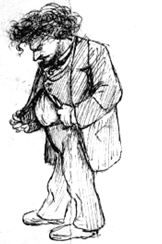 National Trust, was formed in 1895. ……
National Trust, was formed in 1895. ……
xxxxx…… Morris, a larger than life character, was affectionately known as “Topsy” by his friends on account of his unkempt hair and bushy beard. It appears that he was the butt of many practical jokes, most of which he took in good part, but he was known to have bursts of ill-temper. (The pen and ink sketch is by Rossetti.) ……
xxxxx…… In 1861 the company worked from premises in Queen Street, Bloomsbury, but it moved to Hammersmith in London in 1878, and the Merton Abbey works were opened near Wimbledon, Surrey, three years later. ……
xxxxx…… Morris was buried in the churchyard of Kelmscott village church, in October 1896, carried to his grave, we are told, on a yellow farm cart with bright red wheels. It was a fitting end for such a colourful character.
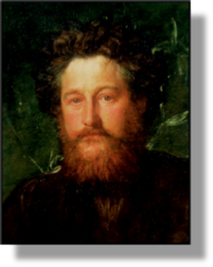 xxxxxIt was the need to restore the quality and originality of individual craftsmanship that led William Morris (1834-1896) to found a company of interior designers and manufacturers in 1861. Known as “The Firm”, its aim, as Morris simply put it, was to produce “decorative articles”. Assisted by the likes of Rossetti, Burne-Jones, Ford Maddox Brown and the architect Philip Speakman Webb, he set out to produce a large variety of household items and decorative goods which were superior in design and quality to the products of “crass materialism” (in the words of Thomas Carlyle). Over the years his company developed and produced a range of items noted for their distinctive beauty. At first it concentrated on the production of stained glass, providing windows for churches and chapels up and down the country, and this put the company on its feet. Much of the art work for this was done by Burne-Jones, but it was Morris who chose the colours and patterned the design. A fine example of the company’s work was the series of glass windows produced for Jesus College Chapel, Cambridge in the mid -1870s.
xxxxxIt was the need to restore the quality and originality of individual craftsmanship that led William Morris (1834-1896) to found a company of interior designers and manufacturers in 1861. Known as “The Firm”, its aim, as Morris simply put it, was to produce “decorative articles”. Assisted by the likes of Rossetti, Burne-Jones, Ford Maddox Brown and the architect Philip Speakman Webb, he set out to produce a large variety of household items and decorative goods which were superior in design and quality to the products of “crass materialism” (in the words of Thomas Carlyle). Over the years his company developed and produced a range of items noted for their distinctive beauty. At first it concentrated on the production of stained glass, providing windows for churches and chapels up and down the country, and this put the company on its feet. Much of the art work for this was done by Burne-Jones, but it was Morris who chose the colours and patterned the design. A fine example of the company’s work was the series of glass windows produced for Jesus College Chapel, Cambridge in the mid -1870s.
xxxxxWithin a few years, however, The Firm (later to become Morris & Co.) had expanded its output to include furniture, textiles, wallpaper, tapestries, tiles and jewellery. Morris in particular learnt a variety of skills from scratch - such as dyeing, weaving and printing - in order to cover all aspects of home decoration. Over the next thirty years, due in large measure to his inspirational guidance, the Pre-Raphaelite movement, in its second coming, made an extensive and lasting contribution to the world of decoration and interior design. Notably successful in this wide range of fine and applied arts were the textiles and wallpapers, many still in vogue today. Morris alone created some fifty wallpaper patterns and over seventy fabric designs, all remarkable for the harmony and freshness of their colours, and many for the beauty of their intricate, stylised patterns of flowers and birds - in keeping, as one would expect, with the detailed decorative style of the medieval illuminated manuscript.

xxxxxThe English Pre-Raphaelite artist Edward Burne-Jones (1833-1898) met Morris at Oxford University and they became life-long friends. He joined Morris’ decorative art company in 1861 and very soon excelled in the making of stained glass windows. His inventive and detailed designs came to be admired in chapels and churches up and down the country. He also assisted in the making of superb tapestries, ceramic tiles and jewellery, and in the 1890s he provided many illustrations for the exquisite volumes designed and printed by Morris’ Kelmscott Press. He gained over night fame as a painter in 1877 when he exhibited eight of his works at the Grosvenor Gallery in London. His highly imaginative, dream-like paintings included The Beguiling of Merlin, The Mirror of Venus and King Cophetua and the Beggar Maid.
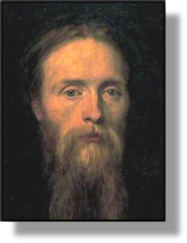 xxxxxAs we have seen, Edward Burne-Jones (1833-1898) met William Morris at Exeter College, Oxford, in the 1850s and they became life-long friends, drawn together by a mutual admiration for the purity of medieval art and the colour and romance of the Arthurian legend. Like Morris, he was intending to join the Church but, attracted by the ideas of John Ruskin and strongly influenced by the charismatic Gabriel Dante Rossetti, he chose to become an artist. He studied painting for a short time under Rossetti, but after assisting Morris in the decoration of Red House, his new home in Bexleyheath, he was drawn into the field of decorative design.
xxxxxAs we have seen, Edward Burne-Jones (1833-1898) met William Morris at Exeter College, Oxford, in the 1850s and they became life-long friends, drawn together by a mutual admiration for the purity of medieval art and the colour and romance of the Arthurian legend. Like Morris, he was intending to join the Church but, attracted by the ideas of John Ruskin and strongly influenced by the charismatic Gabriel Dante Rossetti, he chose to become an artist. He studied painting for a short time under Rossetti, but after assisting Morris in the decoration of Red House, his new home in Bexleyheath, he was drawn into the field of decorative design.
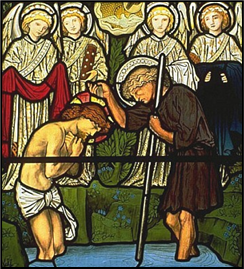
xxxxxHe joined “The Firm” when it was formed in 1861 - the Pre-Raphaelite company dedicated to recreating traditional handicraft - and very soon excelled in the making of stained glass windows. (His Baptism of Christ is illustrated here.) His inventive and detailed designs came to be admired in chapels and churches throughout the country, and as the company widened its range of production he used his skills to good effect in the making of superb tapestries and items such as ceramic tiles and jewellery. Then In the 1890s he provided numerous illustrations for Morris’ Kelmscott Press, producing over eighty alone for its masterpiece, the folio containing The Works of Geoffrey Chaucer. Outstanding among his creations were the tapestry Adoration of the Magi provided for Exeter College Chapel, and the magnificent stained glass windows in St. Philip’s Cathedral in Birmingham, the city of his birth.
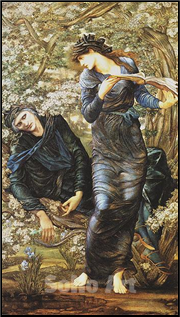 xxxxxDuring his lifetime, however, Burne-Jones was better known as a painter of medieval legend and classical mythology. A number of early works attracted attention, such as Merlin and Nimue and the Chant d’Amour, but fame came overnight in 1877 when he exhibited eight of his paintings at the Grosvenor Gallery in London. These highly imaginative, dream-like works - such as The Beguiling of Merlin (illustrated left) and The Mirror of Venus (illustrated left below) - were filled with a sense of magic and mystery, their beauty and stillness seen as an artistic protest against the harsh dictates of a materialistic age. These and his later works - such as King Cophetua and the Beggar Maid and The Golden Stairway (both illustrated below) - were much in the mould of Pre-Raphaeli
xxxxxDuring his lifetime, however, Burne-Jones was better known as a painter of medieval legend and classical mythology. A number of early works attracted attention, such as Merlin and Nimue and the Chant d’Amour, but fame came overnight in 1877 when he exhibited eight of his paintings at the Grosvenor Gallery in London. These highly imaginative, dream-like works - such as The Beguiling of Merlin (illustrated left) and The Mirror of Venus (illustrated left below) - were filled with a sense of magic and mystery, their beauty and stillness seen as an artistic protest against the harsh dictates of a materialistic age. These and his later works - such as King Cophetua and the Beggar Maid and The Golden Stairway (both illustrated below) - were much in the mould of Pre-Raphaeli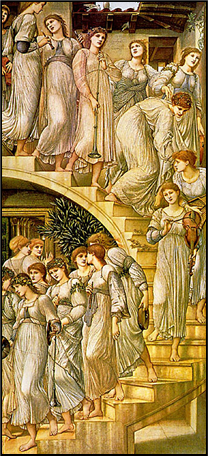 te art, but four visits to Italy - accompanied by Morris on one occasion and Ruskin on another - served to give his style a flavour of the early Renaissance, particularly through the works of Fra Filippo Lippi and Sandro Botticelli. By the mid-1880s he was recognised as one of the country’s leading artists, and his work earned him a baronetcy in 1894.
te art, but four visits to Italy - accompanied by Morris on one occasion and Ruskin on another - served to give his style a flavour of the early Renaissance, particularly through the works of Fra Filippo Lippi and Sandro Botticelli. By the mid-1880s he was recognised as one of the country’s leading artists, and his work earned him a baronetcy in 1894.
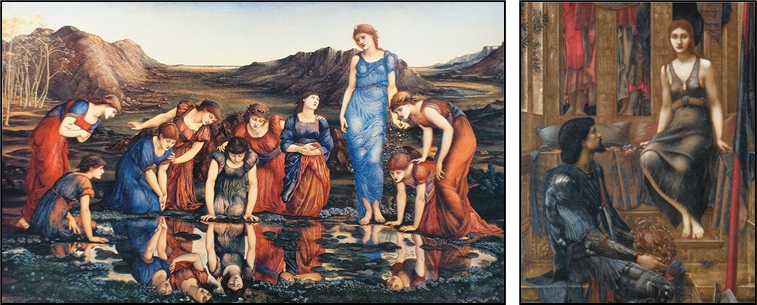
xxxxxIncidentally, Burne-Jones’ wife, Georgiana Macdonald, whom he married in 1860, remained with him despite his affair with the beautiful Greek sculptress Mary Zambaco in the late 1860s. “Georgie” was a close friend of the novelist George Elliot, and through the marriages of her two sisters, Alice and Louisa, she became aunt to the poet and novelist Rudyard Kipling and the politician Stanley Baldwin.
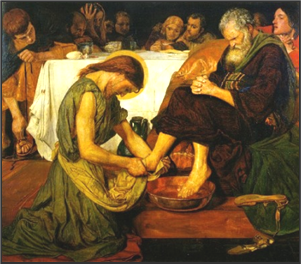
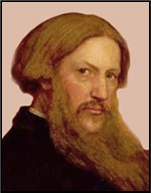
xxxxxThe English artist Ford Madox Brown (1821-1893) had a marked influence on the Pre-Raphaelite movement, though he was never a member as such. In 1857 he assisted Rossetti in decorating the walls of the Oxford Union with scenes from Arthurian legend - the start of the movement’s second phase - and as a member of William Morris’ decorating company, founded in 1861, he worked on both furniture and stained glass designs.
xxxxxHe was drawn to the spiritual values of the German Nazarenes, and many of his paintings, by their intense colour and close detail, show the influence of the early phase of the Pre-Raphaelite Brotherhood. Paintings in the 1850s included Christ Washing St. Peter’s Feet (illustrated above), and his famous painting The Last of England, the moving portrait of a couple leaving England and taking their last look at their homeland. Of particular interest is his series of colourful and imposing murals for Manchester city hall, begun in 1878 to illustrate twelve notable events in the history of the city. Shown below are two stained glass windows: Moses and Jesus Healing a Woman, and (centre) his famous social realist painting entitled Work, a crowded scene which took twelve years to complete and depicts the different classes of workers in Victorian society.
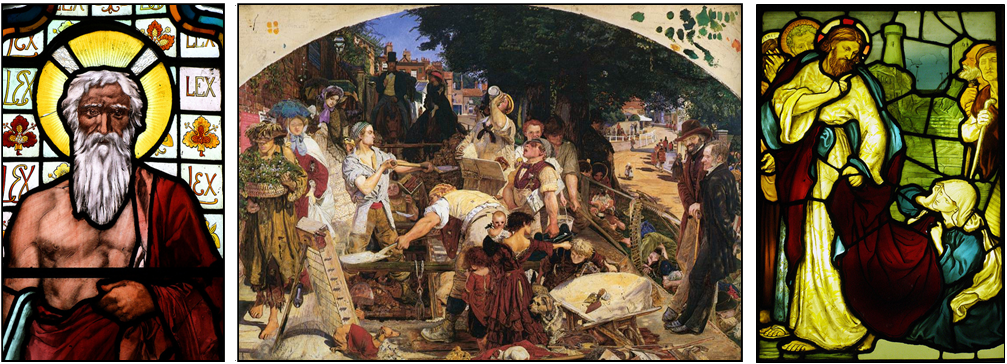
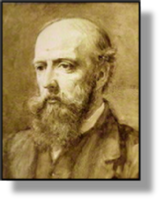 xxxxxThe English architect Philip Speakman Webb (1831-1915) met Morris in 1856 when he was studying architecture in London. They became close friends
xxxxxThe English architect Philip Speakman Webb (1831-1915) met Morris in 1856 when he was studying architecture in London. They became close friends 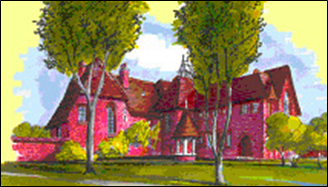 and, as we have seen, in 1859 he drew up the plans for Red House, Morris’ “Palace of Art” at Bexleyheath in south-east London (here illustrated). He designed rustic furniture, fine table glassware and metalwork for Morris’s company, and joined him in the founding of the Society for the Protection of Ancient Buildings in 1877, and his revolutionary Socialist League in 1884.
and, as we have seen, in 1859 he drew up the plans for Red House, Morris’ “Palace of Art” at Bexleyheath in south-east London (here illustrated). He designed rustic furniture, fine table glassware and metalwork for Morris’s company, and joined him in the founding of the Society for the Protection of Ancient Buildings in 1877, and his revolutionary Socialist League in 1884.
xxxxxHis town and country houses were influenced by medieval styles and the Gothic Revival movement, but they were informal and unpretentious in design. His only church building, that of St. Martin’s at Brampton, Cumbria, is remarkable for its unusual ground plan - almost square in shape - and for its exquisite stained glass windows, the work of his friend Edward Burne-Jones.
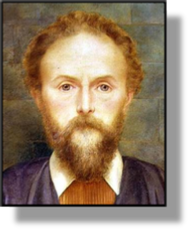
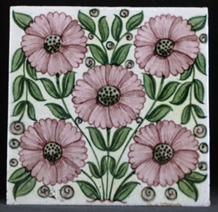 xxxxxWilliam De Morgan (1839-1917) was born in Chester, England, and studied for a short while at the Royal Academy. He met Morris in 1863 and initially assisted him in painting furniture and making stained glass, but he latter turned his hand to making pottery - particularly ceramic tiles -, and he quickly showed an exceptional talent in this skill. He set up his own workshop in Chelsea in 1872, and over the next ten years studied new methods of firing, devised a better means of pattern transfer, and greatly improved the technique of creating lustres and glazes. He moved his works to Merton Abbey, Surrey, near Morris’ premises, in 1882, but returned to London (Fulham) six years later.
xxxxxWilliam De Morgan (1839-1917) was born in Chester, England, and studied for a short while at the Royal Academy. He met Morris in 1863 and initially assisted him in painting furniture and making stained glass, but he latter turned his hand to making pottery - particularly ceramic tiles -, and he quickly showed an exceptional talent in this skill. He set up his own workshop in Chelsea in 1872, and over the next ten years studied new methods of firing, devised a better means of pattern transfer, and greatly improved the technique of creating lustres and glazes. He moved his works to Merton Abbey, Surrey, near Morris’ premises, in 1882, but returned to London (Fulham) six years later.
xxxxxAs one would expect, many of his dishes and tiles were medieval in design, but, inspired by wares from the East, he also produced a range of “Persian” colours, and these included brilliant greens and blues, a manganese purple, and a deep red lustre. Many of his tiles had detailed floral patterns, but his designs also came to be well known for their amusing array of “fantastical” fish, birds and other weird creatures, some of them made in conjunction with Edward Burne-Jones. These distinctive patterns and striking colours brought him some wealthy clients, including the Tsar of Russia and the P&O Shipping Line, but by the turn of the century his work had lost favour. As a result, in 1906 potter turned author and began to make a better living writing novels. Among these were his Joseph Vance - an instant success – and It Can Never Happen Again.

xxxxxIncidentally, many of his drawings - some 1,200 items in all - were bequeathed by his widow to the Victoria and Albert Museum in London, and over 250 of his ceramics are on display at the De Morgan Centre in Wandsworth, London.






 xxxxxAs we have seen, the Pre-
xxxxxAs we have seen, the Pre-

 xxxxxAnd it was also in the 1890s that Morris established his Kelmscott Press in Hammersmith, London, to fulfil his love of medieval books and illustrated manuscripts. This press produced 69 exquisite handmade volumes, distinctively embellished by three new Gothic typefaces, woodcut illustrations by Burne-
xxxxxAnd it was also in the 1890s that Morris established his Kelmscott Press in Hammersmith, London, to fulfil his love of medieval books and illustrated manuscripts. This press produced 69 exquisite handmade volumes, distinctively embellished by three new Gothic typefaces, woodcut illustrations by Burne- National Trust, was formed in 1895. ……
National Trust, was formed in 1895. …… xxxxxIt was the need to restore the quality and originality of individual craftsmanship that led William Morris (1834-
xxxxxIt was the need to restore the quality and originality of individual craftsmanship that led William Morris (1834-
 xxxxxAs we have seen, Edward Burne-
xxxxxAs we have seen, Edward Burne-
 xxxxxDuring his lifetime, however, Burne-
xxxxxDuring his lifetime, however, Burne- te art, but four visits to Italy -
te art, but four visits to Italy -



 xxxxxThe English architect Philip Speakman Webb (1831-
xxxxxThe English architect Philip Speakman Webb (1831- and, as we have seen, in 1859 he drew up the plans for Red House, Morris’ “Palace of Art” at Bexleyheath in south-
and, as we have seen, in 1859 he drew up the plans for Red House, Morris’ “Palace of Art” at Bexleyheath in south-
 xxxxxWilliam De Morgan (1839-
xxxxxWilliam De Morgan (1839-


